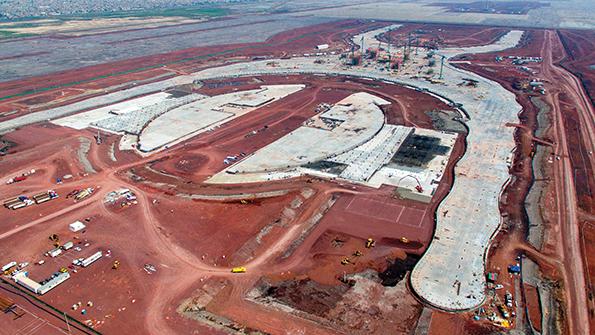
What a turnaround. In 2018, Mexico was a darling of the aerospace world. Investment poured in, making it one of the most popular “best-cost” locations on the planet. The number of aerospace suppliers exceeded 300—up from just 100 15 years prior, and the value of exports exceeded $9 billion. All of this was underpinned by a vibrant aviation sector. Four airlines—AeroMexico, Volaris, Interjet and VivaAerobus—served a fast-growing domestic market, while a futuristic new airport was under construction outside of Mexico City (see photo). It would become the largest in Latin America and position the country as a global transportation hub.
All of this changed in 2018 with the election of Andres Manuel Lopez Obrador (AMLO) as president. AMLO is an unusual politician: a fiscally conservative, antibusiness populist known for his incorruptibility. Two months before taking office, he held a hastily organized plebiscite to determine if construction of the airport should continue. Despite just 1% of Mexicans voting, the airport project was voted down. Termination costs were an estimated $5 billion for the $13-15 billion project. The Mexican stock market fell by 4% in response.
Next, AMLO put the Boeing 787 presidential aircraft up for sale and promised to use the proceeds to fight the transit of illegal immigrants through Mexico. He later announced the intent to sell 39 government-owned helicopters and 33 government-owned aircraft. Preferring to travel in economy class, he banned his cabinet from taking trips in executive jets owned by the government.
Then the Boeing 737 MAX grounding followed by the COVID-19 crisis dealt Mexico a one-two punch. While airlines and aerospace suppliers in other countries received government support and loans to survive the crisis, the response from AMLO was nada.
The results of inaction were predictable. AeroMexico and Interjet declared bankruptcy. An estimated 5-10% of aerospace suppliers failed. Mexico’s partially completed gateway airport remains in mothballs, and the presidential airplane—too expensive to convert for airline use—did not sell after racking up $1.5 million in maintenance costs. And in May 2021, the FAA downgraded Mexico’s aviation safety rating.
Over the past three years, Mexico scored the aerospace equivalent of an “own goal.”
Fortunately, all is not lost, and significant opportunities remain, if Mexico can right the ship. Mexico’s economy is now on the rebound after contracting 8.5% in 2020, and it is heading for growth of 6% or more this year, helped by President Joe Biden’s $1.9 trillion U.S. stimulus package. One of the few open international travel corridors is between the U.S. and Mexico, and travel between the two countries should expand considerably when the COVID-19 crisis ebbs. The search for aerospace suppliers in “best-cost” countries will continue, and Mexico is in an excellent position, given its competitive labor rates, proximity to the U.S. and membership in the new U.S.-Mexico-Canada trade agreement.
An additional factor in Mexico’s favor is OEMs’ desire to create more geographically concentrated supply chains and reduce the total travel distance of parts—to improve not only productivity but also supply chain sustainability, including reducing emissions and expanding scrap reuse. The COVID crisis reinforced this logic when B2B transportation systems broke down, particularly maritime shipping, and air cargo costs skyrocketed.
Perhaps Mexico’s greatest opportunity lies in geopolitics, specifically China’s “great power” rivalry with the U.S. and increasingly with Europe and Canada. As a result, OEM supply-chain strategies have morphed from offshoring to onshoring and now “ally-shoring,” which is like onshoring, except reliable friends and allies are also deemed acceptable sources. While OEMs and governments fear ongoing Chinese theft of intellectual property and competition from government-subsidized Comac and Avic, Mexico is a trusted partner.
What about AMLO? Despite his disdain for business, he remains popular with Mexican voters. However, he must leave office in September 2024.
The “own goal” scored by Mexico after decades of growth is a reminder of the importance of stable political leadership and creative policies in times of crisis. With jetliner production rates finally beginning to increase, the surviving Mexican suppliers can get back to work, mend their balance sheets and do what they do best: Be a reliable best-cost partner for manufacturing; maintenance, repair and overhaul; and engineering.
The aerospace industry needs a healthy Mexico. Is anyone in Mexico City listening?






Comments